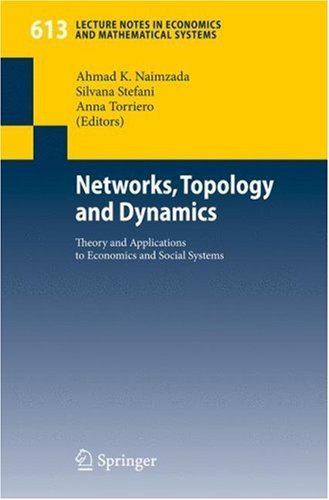Reviewed by
Jennifer Claire Auer and Erik Johnston
Center for Policy Informatics, School of Public Affairs, Arizona State University
 This edited collection of articles is a balanced introduction to network analysis for students and researchers in the quantitative social sciences and engineering. Scholars who are already active in the field, particularly those who study economic systems, will also find it useful for the numerous articles that push the current boundaries of network theory.
This edited collection of articles is a balanced introduction to network analysis for students and researchers in the quantitative social sciences and engineering. Scholars who are already active in the field, particularly those who study economic systems, will also find it useful for the numerous articles that push the current boundaries of network theory. The volume has an interesting history. It emerged from annual deliberations on networks that are convened in Italy, a country that has been a leader in the analysis of economic-focused networks. For example, Italy's 'business districts' have been highly successful and under close study for their remarkable innovation capacity. The districts are comprised of niche entrepreneurs that compete, but simultaneously cooperate through informal, information-sharing networks. The networks have posed an interesting anomaly for traditional market models to explain, but they may be the answer to economic development woes. The business districts are just one example of how, in the words of the book's closing article, real-world problems are being turned into mathematical ones through the promising field of network analysis.
Networks, Topology and Dynamics: Theory and Applications to Economics and Social Systems is a volume aptly named; two of its four sections focus on theory and two on application. It begins and ends with how to apply network analysis to research problems. The second article by Michael D. Konig and Stefano Battiston is a particularly well-written tutorial on economic networks that deftly strikes that difficult mix of breadth and depth that is also accessible to all readers. In some chapters in this section, there are a small number of problem sets can help readers work through the mathematical intuition of graph theory. Overall, the first chapters provide a useful background on graph theory basics, different types of network formation, and the conventional measures used to describe networks. However, not every article contains problem sets and they are not consistent enough to be a major part of classroom activity in a networking course.
The book's middle chapters present a series of articles on developments in network theory and methodology. They include advances in modeling the behavioral underpinnings of networks and in graph theory as applied to economic and social systems. It departs from the instructional aim of the other sections by building on past networking models and conundrums by including more thorough mathematical proofs. The chapters are only loosely unified under network dynamism and so lack a compelling educational framework or context, but they do provide a decent survey of quality network research and are interesting in their own right. Each of the authors make clear efforts to direct the reader to other resources for further discussion on the topic so that students who are new to the field can use a relevant chapter as a starting point for further research. On their face, these chapters will likely be of most interest to researchers already active in the field. Nevertheless, the articles may spark interest and provide direction for new network analysts through the authors' suggested next steps and model extensions.
Through their sample of five network models in the last section of the book, the editors seem to select authors that demonstrate a diversity of approaches and convey the potential of the network perspective to understanding dynamic interaction processes. Given the economic theme of most examples in the volume, one of the more unusual models is concerned with the social outcomes in its investigation of team member selection and ultimately of the emergence of leaders during group formation. The authors construct a network model in which agents participate in a repeated public goods game, each agent investing some level of effort and each reaping the benefit of combined team productivity. The model was able to reproduce the phenomena of cliques and some of the team stages observed in empirical data, including forming and norming. In the end, the authors illustrate the importance of the number and relative distance of leaders in the network. We can look forward to future research on this topic that incorporates memory, reputation and other forms of social cognition into the agents' leadership and team member selection choices.
The purpose of the Lecture Notes in Economics and Mathematical Systems series, the home of this volume, is to provide a forum to highlight research developments within a specific area. Thus, the authors and editors should be applauded for taking steps to expand the field's reach and include the next generation of network analysts in their latest discoveries. Each of the chapters is well-structured and flows logically from section to section. After the introductory chapters, subsequent articles can be read independently according to interest. Brief abstracts and introductions, conclusions and explanatory topic sentences, almost to the point of being repetitious, accompany each chapter. The writing style is clear and the text generally well-edited. Each of these attributes serves the reader well to stay oriented between the article's diverse topics.
For readers of JASSS, this volume is an accessible guide to network analysis that you may find a useful complement while teaching a social science course on the topic. Students with a strong mathematics or economics background will benefit the most from the book. JASSS readers will also benefit from the insights of more than a dozen rising colleagues in network theory and analysis. The volume joins a handful of other similarly-focused books on the subject.
Return to Contents
of this issue
© Copyright Journal of Artificial Societies and Social Simulation, 2009